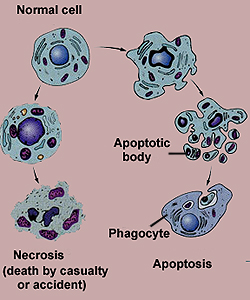Apoptosis is the process of
planned cell death, or cell removal. It may occur if a cell is
damaged beyond reclaim, or simply if it has outlived its usefulness.
Some cells with dense, darkly stained
chromatin in tissues with high rates of cell turnover are undergoing
programmed cell death (apoptosis) rather than mitosis.
- The two processes can be
difficult to distinguish in routinely stained slides.
- As shown in the adjacent figure, cells
undergoing apoptosis have their chromatin clumped into a uniform
dense mass (pyknotic nuclei) with no indication of chromosomes
as in mitosis.
- Apoptosis and mitosis generally
occur in different regions of tissues.
- Examine the small intestine
(slide 4), looking for pyknotic cells near the tips of the
projecting villi.
- The sequence of events leading
to apoptosis is also initiated when a cell’s nuclear DNA is
damaged beyond repair.
-
Slide 156 is skin from a
mouse treated with ultraviolet radiation and shows apoptotic
cells in the epidermis.
Pathology includes the study of cell
death both by apoptosis and by necrosis.
- What is the major
difference between these two processes with regard to the roles of
other cells involved?
Let's now take a look at
specific tissue types and their cellular
constituents. |